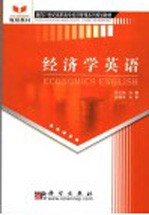

经济学英语PDF电子书下载
- 电子书积分:11 积分如何计算积分?
- 作 者:任志纯主编
- 出 版 社:北京:科学出版社
- 出版年份:2004
- ISBN:7030141083
- 页数:259 页
目录 1
Chapter 1 Ten Principles of Economics 1
Principle 1 People face tradeoffs 3
Principle 2 The cost ofsomething is what you give to get it 6
Principle 3 Rational people think at the margin 7
Principle 4 People respond to incentives 9
Principle 5 Trade can make everyone better off 12
Principle 6 Markets are usually a good way to organize economic activity 13
Principle 7 Governments can sometimes improve market outcomes 15
Principle 8 A country's standard of living depends on its ability to produce goods and services 18
Principle 9 Prices rise when the government prints too much money 20
Principle 10 Society faces a short-run tradeoff between inflation and unemployment22 Questions for review 23
Chapter 2 Interpendence and the Gains from Trade 24
A parable for the modern economy 25
The need and motivation for international trade 32
Absolute advantage and comparative advantage 35
Applications of comparative advantage 37
The legacy ofadam smith and david ricardo 39
Questions for review 41
Chapter 3 The Market Forces of Supply and Demand 42
The determinants of individual demand 44
The demand schedule and the demand curve 46
Market demand versus individual demand 48
Shifts in the demand curve 49
The determinants of individual supply 52
The supply schedule and the supply curve 53
Market supply versus individual supply 54
Shifts in the supply curve 56
Equilibrium 57
The determinants of the deadweight loss 1 58
Three steps to analyzing changes in equilibrium 60
Conclusion:How price allocate resources 63
Deadweight loss and tax revenue as taxes vary 1 63
Question for review 65
The elasticity of demand 66
Chapter 4 Elasticity and Its Application 66
The elasticity of supply 74
Applications of supply,demand,and elasticiy 77
Questions for review 84
Chapter 5 Supply,Demand,and Government Policies 85
Controls on prices 86
Taxes 97
Conclusion 106
Questions for review 106
Chapter 6 Production Costs 107
The production function 109
Variable costs versus fixed costs 110
Production decisions in the short run and long run 112
Diminishing returns in production 114
Maximizing profit and the production decision 116
Economies and diseconomies of scale 119
The experience curve 127
Optimal scale and X-inefficiency 129
Conclusion 131
Chapter 7 Consumers,Producers,and the Efficiency of Markets 133
Consumer surplus 134
Producer surplus 141
Market efficiency 145
Conclusion 149
Questions for review 151
Chapter 8 The Costs of Taxation 152
The deadweight loss of taxation 153
Questions for review 168
Conclusion 168
Chapter 9 Public Goods and Common Resources 169
The different kinds of goods 169
Public goods 171
Common Resources 179
Questions for review 185
Chapter 10 Measuring a Nation's Income 186
The economy's income and expenditure 187
The measurement ofgross domestic product 189
The components of GDP 193
Real versus nominal GDP 195
GDP and economic well-being 199
Conclusion 203
Questions for review 203
Chapter 11 Aggregate Demand and Aggregate Supply 205
Three key facts about economic fluctuations 206
Explaining short-run economic fluctuations 208
The aggregate-demand curve 211
The aggregate-supply curve 216
Two causes of recession 223
Conclusion:The orgins of aggregate demand and aggregate supply 230
Questions for review 231
The essence of fiscal policy 232
Chapter 12 Management ofthe Economy Ⅰ:Fiscal Policy 232
Problems with fine-tuning aggregate demand 234
Government borrowing 237
Conclusion 241
Chapter 13 Management of the Economy Ⅱ:Monetary Policy 243
The essence of monetary policy 243
Principles of monetarism 245
Measuring the money supply 248
The effects of monetary policy on business 255
Conclusion 257
主要参考文献 259
- 《信息系统安全技术管理策略 信息安全经济学视角》赵柳榕著 2020
- 《革命根据地军事经济史》龚泽琪主编 1994
- 《经济侵略与中国》高尔松,高尔柏 1925
- 《面向可持续发展的马克思主义经济科学研究》刘正刚,李晓,田军著 2018
- 《环境启动经济》张继亮 2019
- 《微观经济学》(美)罗伯特·S. 平狄克,(美)丹尼尔·L.鲁宾费尔德著 2019
- 《“知识新探索”百科丛书 经济学的世界 全彩版》(英)泰吉万·帕丁格 2019
- 《海河干流水环境质量与经济发展模式研究》于航白景峰,张春意 2019
- 《经济转型时期中国环境规制政策问题研究》冯卓著 2019
- 《新中国经济建设70年》蔡昉主编 2019
- 《指向核心素养 北京十一学校名师教学设计 英语 七年级 上 配人教版》周志英总主编 2019
- 《《走近科学》精选丛书 中国UFO悬案调查》郭之文 2019
- 《北京生态环境保护》《北京环境保护丛书》编委会编著 2018
- 《中医骨伤科学》赵文海,张俐,温建民著 2017
- 《美国小学分级阅读 二级D 地球科学&物质科学》本书编委会 2016
- 《指向核心素养 北京十一学校名师教学设计 英语 九年级 上 配人教版》周志英总主编 2019
- 《强磁场下的基础科学问题》中国科学院编 2020
- 《小牛顿科学故事馆 进化论的故事》小牛顿科学教育公司编辑团队 2018
- 《小牛顿科学故事馆 医学的故事》小牛顿科学教育公司编辑团队 2018
- 《高等院校旅游专业系列教材 旅游企业岗位培训系列教材 新编北京导游英语》杨昆,鄢莉,谭明华 2019
